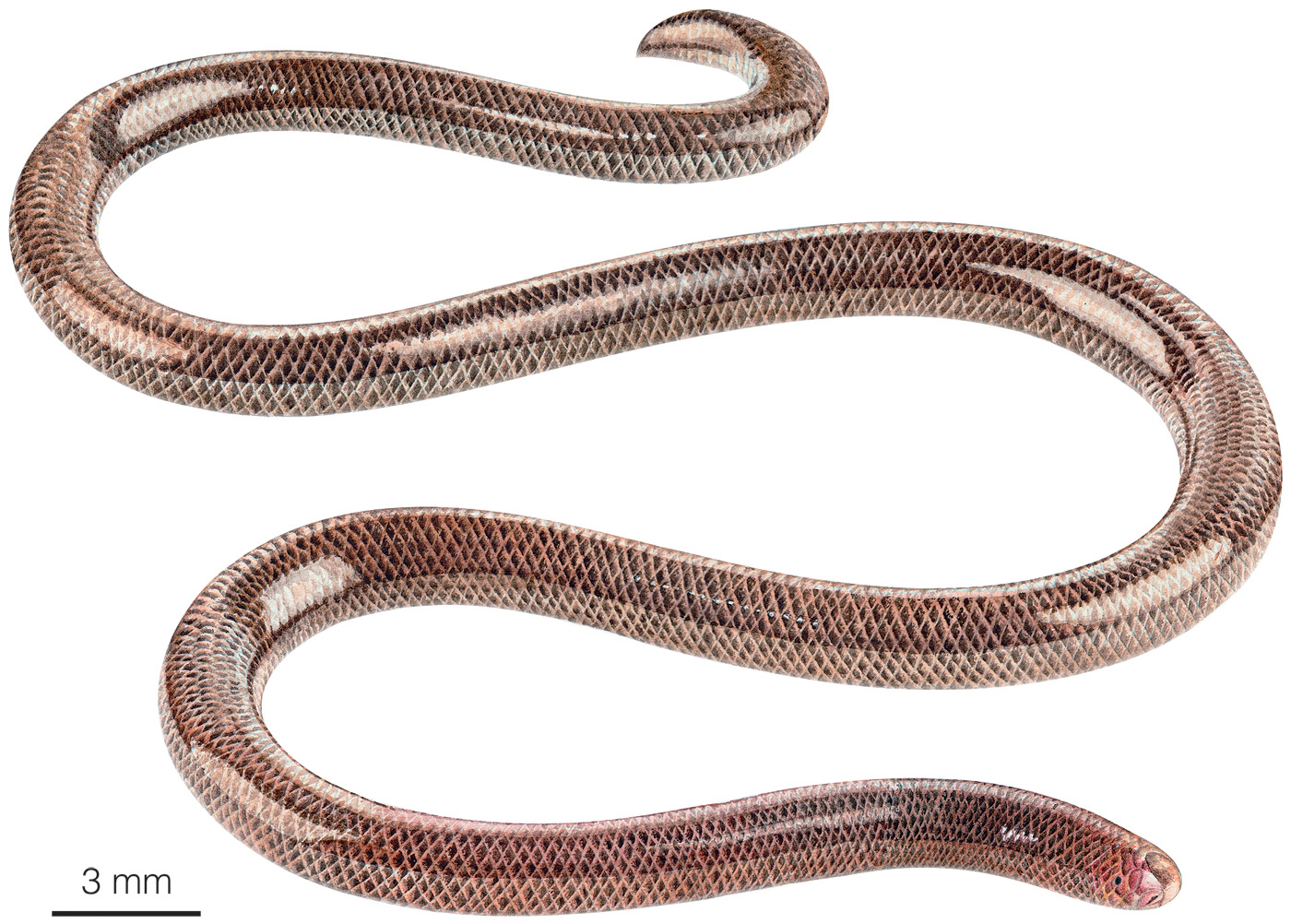Published February 4, 2024. Open access. | Purchase book ❯ |
Peters’ Blind-Snake (Liotyphlops petersii)
Reptiles of Ecuador | Serpentes | Anomalepididae | Liotyphlops petersii
English common name: Peters’ Blind-Snake.
Spanish common name: Culebra ciega de Peters.
Recognition: 11.0 cm.1 Liotyphlops petersii is a dwarf, archaic looking snake characterized by having eyes that are rudimentary and concealed under a scale, and by having ventral scales similar in size to dorsals.2,3 This species differs from other blind snakes occurring in western Ecuador by having an extremely wide and short frontal scale.1,3 Furthermore, the rostral scale extends to between the eyes and has a truncate posterior border in broad contact with the frontal scale, precluding the prefrontals from contacting each other.1,3,4 Unlike Epictia subcrotilla, this species lacks a yellow spot on the head and on the tail-tip.5 The entire body is dark brown, with each scale darker in the center (Fig. 1).1

Figure 1: Illustration of an adult individual of Liotyphlops petersii based on photographs of the holotype.
Natural history: Liotyphlops petersii is an extremely rare fossorial snake that inhabits an area of seasonally dry forest and savanna.1 Nothing is known about the ecology of this species, but Liotyphlops snakes in general are diurnal and dwell in soft soil, leaf-litter, or under logs.6,7 They are oviparous and feed on larvae and pupae of ants,8 as well as on centipedes and spiders.7 These fossorial creatures are usually only forced onto the surface after heavy rains, when their burrows flood.6
Conservation: Data Deficient There is inadequate information to make an assessment of extinction risk.. Liotyphlops petersii is included in this category because there is inadequate information to make an assessment of its extinction risk based on its scarce distribution data. The species is only known for certain from the type locality (Fig. 2), where it was last seen in 1857. An additional specimen4 from the city of Esmeraldas province almost surely corresponds to a different species (or genus).
Distribution: Liotyphlops petersii is known only from the type locality: Guayaquil, Guayas province, Ecuador (Fig. 2).

Figure 2: Distribution of Liotyphlops petersii in Ecuador. See Appendix 1 for a complete list of the presence localities included in the map.
Etymology: The generic name Liotyphlops is derived from the Greek words leios (=smooth) and typhlops (=blind).9 The specific epithet petersii honors German naturalist Wilhelm Peters (1815–1883), in recognition of his contributions to the systematics of blind snakes.
See it in the wild: The Peters’ Blind-Snake has only been seen once in 1857, suggesting the species is either extinct, not valid to begin with, or just extremely rare. The two Ecuadorian anomalepids are undoubtedly the rarest snakes in the country, with no more than two observations each. Since all attempts to recover additional specimens of Liotyphlops petersii have failed, it is possible that the holotype was in fact from another locality and ended up in Guayaquil via human transport. Blind snakes in general are notorious for being stowaways in flowerpots, resulting in the snakes being “planted” in gardens.
Author: Alejandro ArteagaaAffiliation: Fundación Khamai, Reserva Arlequín, Ecoruta Paseo del Quinde km 56, Santa Rosa de Mindo, Pichincha 171202, Ecuador.
Illustrator: Valentina Nieto Fernández
How to cite? Arteaga A (2024) Peters’ Blind-Snake (Liotyphlops petersii). In: Arteaga A, Bustamante L, Vieira J (Eds) Reptiles of Ecuador: Life in the middle of the world. Available from: www.reptilesofecuador.com. DOI: 10.47051/NTHZ8679
Literature cited:
- Boulenger GA (1889) Descriptions of new Typhlopidae in the British Museum. Ann. Mag. nat. Hist. (6) 4: 360-363. Annals and Magazine of Natural History 4: 360–363.
- Peters JA, Orejas-Miranda B (1970) Catalogue of Neotropical Squamata: part I, snakes. Bulletin of the United States National Museum, Washington, D.C., 347 pp.
- Dixon JR, Kofron CP (1984) The Central and South American anomalepid snakes of the genus Liotyphlops. Amphibia-Reptilia 4: 241–264.
- Linares-Vargas CA, Bolívar-García W, Herrera-Martínez A, Osorio-Domínguez D, Ospina OE, Thomas R, Daza JD (2021) The status of the anomalepidid snake Liotyphlops albirostris and the revalidation of three taxa based on morphology and ecological niche models. The Anatomical Record 304: 2264–2278. DOI: 10.1002/ar.24730
- Peters JA (1957) Taxonomic notes on Ecuadorian snakes in the American Museum of Natural History. American Museum Novitates 1851: 1–13.
- Leenders T (2019) Reptiles of Costa Rica: a field guide. Cornell University Press, Ithaca, 625 pp.
- Marques OAV, Eterovic A, Barreto Guedes T, Sazima I (2017) Serpentes da Caatinga. Ponto A, Florianópolis, 240 pp.
- Parpinelli l (2008) História natural da cobra cega Liotyphlops beui. MSc thesis, Universidade Estadual Paulista, 78 pp.
- Brown RW (1956) Composition of scientific words. Smithsonian Books, Washington D.C., 882 pp.